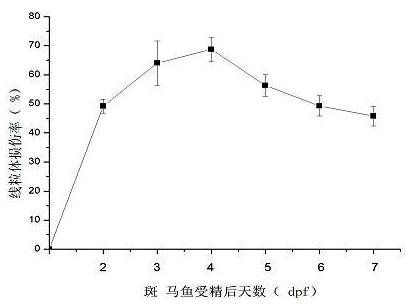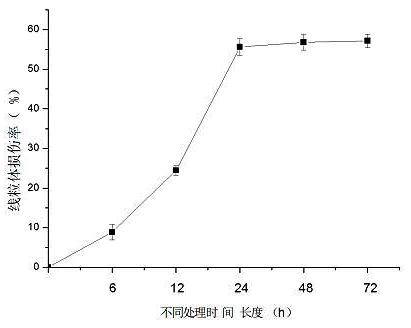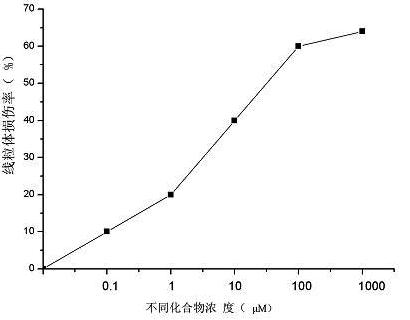Method for screening mitochondria targeted compounds by using zebra fish
A compound and mitochondrial technology, applied in the field of compound (chemical) detection, can solve the problems of difficult quantitative analysis, complicated experimental operation, cell damage, etc., and achieve the effect of avoiding interaction, simple administration method, and short sexual maturity cycle
- Summary
- Abstract
- Description
- Claims
- Application Information
AI Technical Summary
Problems solved by technology
Method used
Image
Examples
Embodiment 1
[0181] (1) Selection of zebrafish
[0182] The 4dpf zebrafish were observed under a dissecting microscope, and the normally developed zebrafish were picked and transferred into 48-well plates, 10 in each well.
[0183] (2) Compound treatment
[0184] Set up 8 experimental groups: 5 drug treatment groups to be tested, 1 mitochondrial damage positive control group, 1 solvent control group, and 1 blank control group. Remove the culture water in the microwell plate, and add 1mL doxorubicin with concentrations of 0.1μM, 1μM, 10μM, 100μM, and 1000μM to the five drug treatment groups to be tested respectively. [26] solution; in the positive control group, 1 mL of etoposide solution with a concentration of 50 μM was added; in the solvent control group, 1 mL of DMSO with a concentration of 0.1% was added; in the blank control group, 1 mL of aquaculture water was added. Incubate for 24 hours in a constant temperature incubator at 28°C.
[0185] (3) Dyeing treatment
[0186] The solv...
Embodiment 2
[0203] (1) Selection of zebrafish
[0204] The 4dpf zebrafish were observed under a dissecting microscope, and the normally developed zebrafish were picked and transferred to a 48-well plate, with 10 fish per well.
[0205] (2) Compound treatment
[0206] Set up 8 experimental groups: 5 groups treated with environmental toxic compounds to be tested, 1 mitochondrial damage positive control group, 1 solvent control group, and 1 blank control group. Remove the breeding water in the microwell plate, and add 1 mL of the environmentally toxic compound Nonglin at a concentration of 0.1 μM, 1 μM, 10 μM, 100 μM, and 1000 μM to the five treatment groups of environmentally toxic compounds to be tested. [27] solution; in the positive control group, 1 mL of staurosporine solution with a concentration of 50 μM was added; in the solvent control group, 1 mL of DMSO with a concentration of 0.1% was added; in the blank control group, 1 mL of aquaculture water was added. Incubate for 24 hours ...
Embodiment 3
[0225] The present embodiment carries out according to the following steps:
[0226] (1) Selection of zebrafish
[0227] The 4 dpf zebrafish were observed under a dissecting microscope, and the normally developed zebrafish were picked and transferred to a 96-well plate, with one fish per well.
[0228] (2) Compound treatment
[0229] Eight experimental groups were set up: 5 candidate antineoplastic drug treatment groups, 1 mitochondrial damage positive control group, 1 solvent control group, and 1 blank control group. Remove the culture water in the microwell plate, and add 150 μL of the candidate antineoplastic drug teniposide at concentrations of 0.1 μM, 1 μM, 10 μM, 100 μM, and 1000 μM to the five candidate antitumor drug treatment groups. [28] solution; 150 μL of 50 μM etoposide solution was added to the positive control group; 150 μL of 0.1% DMSO was added to the solvent control group; 150 μL of aquaculture water was added to the blank control group. Incubate for 24 ho...
PUM
 Login to View More
Login to View More Abstract
Description
Claims
Application Information
 Login to View More
Login to View More - R&D
- Intellectual Property
- Life Sciences
- Materials
- Tech Scout
- Unparalleled Data Quality
- Higher Quality Content
- 60% Fewer Hallucinations
Browse by: Latest US Patents, China's latest patents, Technical Efficacy Thesaurus, Application Domain, Technology Topic, Popular Technical Reports.
© 2025 PatSnap. All rights reserved.Legal|Privacy policy|Modern Slavery Act Transparency Statement|Sitemap|About US| Contact US: help@patsnap.com



